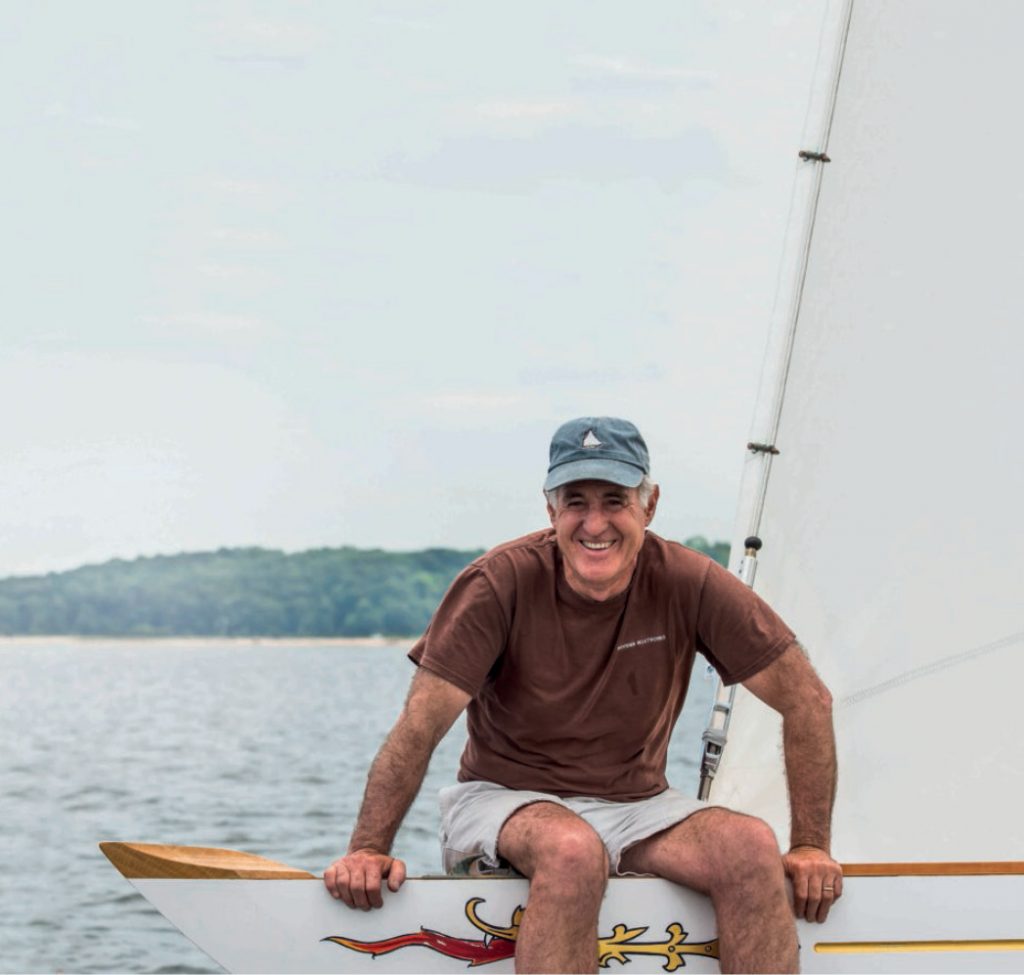
Master boatbuilder Donn Costanzo aboard one of his creations, the 8 Metre Defender © Ben Mendlowitz
At the end of the North Fork of Long Island, there’s a fishing and boating town called Greenport. For most, it’s the jumping off point via ferry for Shelter Island, long past its origins as a sleepy Quaker refuge. Shelter Island is home to the largest concentration of classic boats out East. That fleet numbers as many as fifty fiberglass Doughdish sloops, Cape Cod Shipbuilding’s transcription of Herreshoff’s most prolific 1914 design, the Herreshoff 12 ½. At the more modern end of the classic spectrum, Shelter Island has the area’s largest fleet of Etchells 22s, a design that just turned 58.
Back across the channel in Greenport, for a generation before he retired, Donn Costanzo was a captain of the wooden boat industry. The master boatbuilder at Wooden Boatworks, he’s the Geppetto of Long Island who brought dozens of vintage boats not just back to life but to active racing form.
We had followed the Donn story for many seasons before having a gam with Hunt Lawrence, patron and curator of the Classics fleet at Oakcliff Sailing in Oyster Bay. A resident of three islands (Centre Island, Fire Island and Manhattan), Hunt is an avid sailor with unique taste in historic wooden boats.
Donn told his own story in a recent YouTube interview:
“I was raised in Sayville on the South Shore of Long Island, very close to the Great South Bay. I think I was a freshman in high school. I was over on Fire Island and I saw an absolutely gorgeous boat. It was a boat that Al Terry from Bayport had restored. It was a B-Class sloop called Melody. Al had this old gaff-rigged sloop in his boatyard. Her name was Salty and he said, ‘Why don’t I restore that and that I could sail it.” I think he knew I didn’t have the money to buy the boat, but I had the interest and that was all that mattered to him.
He taught me how to survey a boat, and how you start with the major structural timbers in the boat, the stern, the apron, the sternpost, the tail feathers and you work your way up to the frame. And through his instruction I was able to learn just by looking a lot of times, at the different techniques that people used in building boats.”
Donn moved on to work in Europe, both building and restoring boats before returning to Long Island in 1994. He worked on restoring Beetle Cats, a class well known to Long Island and New England sailors. From there, he began restoring the boats of Great South Bay designer Gil Smith.
In his same YouTube post, Donn described his fascination with the art of wooden boatbuilding and how he got into the business: “Those were the early days, but it wasn’t until I went to Lance Lee’s apprentice shop that I learned classical boat building and I felt at that point that I had some skill that was marketable. I was attracted to the sheer beauty of them: absolutely gorgeous to look at, very sweet lines, the curves, and the perspectives. To me, they are art.”
Donn and his brother made a deal to start Wooden Boatworks as a tenant in the former Hanff boatyard in Greenport. “My brother Bruce and I met with John and George Costello, who told us they had bought the yard under certain conditions. The agreement was that if anyone bought the boatyard they would keep it as a boatyard, and it would not get turned into condominiums or apartment houses. John and George purchased it and they had been looking for years for a wooden boat builder. I told him that’s what we did and would like to do it and they were an incredible support to Bruce and I with Wooden Boatworks.” (In 2022, a new owner bought the property with the same conditions.)
“The reason people come to us is because of our appreciation for the historical end of yachts and also the technical ability to do it the way it was done before. In boat building, you have to use the species of wood that best serves the job. You are not going to put oak on a deck – it’s not going to work out very well with the sunlight. You need a wood that’s going to expand and contract so the deck doesn’t open up in the heat and leak when it rains…and it’s getting more and more difficult to purchase timber.
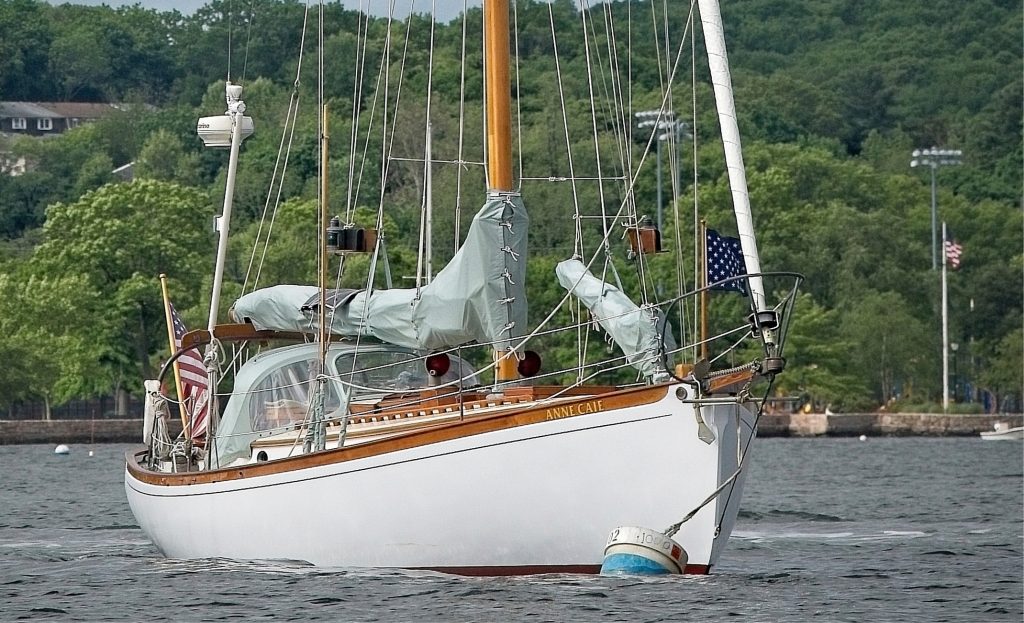
Designed by Sam Crocker with a distinctive spoonish bow, the cutter Anne Caie was among the first boats in the Oakcliff Classics fleet. © Peter Taylor
The Classics Fleet of Oyster Bay
I first experienced Donn’s work first in the shape of Dolphin, a boat I was privileged to sail in Oyster Bay and in a series of Opera House Cups on Nantucket from 2015 to ‘18.
If you visit Oyster Bay in the sailing season, you’ll see a century of boat design from the north to the south reaches of the anchorage. To the south, you gape at the high-tech speedsters of Oakcliff Sailing’s donated maxis and mini maxis with spars and bowsprits of carbon…not a scrap of wood in sight.
On the north side of the harbor, west of Seawanhaka Corinthian Yacht Club, float nearly two dozen boats comprising the Classics Fleet, tucked under Centre Island. This is the fleet that Hunt Lawrence has been working with Donn for a decade to assemble and restore; all done by notable yacht designers including William Fife III, Olin Stephens, Phil Rhodes and Bill Luders. These beauties head out into Oyster Bay on Thursday and Friday afternoons with sixty to a hundred sailors for ‘round the buoys pursuit racing. There are young sailors and seniors; a dedicated group that treasure their wooden vessels.
When I first saw the Classics in October 2014, the 36-foot Newport 29 Dolphin was my ride. The N-29, along with its little brother the Alerion, became the subject of my first Conversations with Classic Boats podcasts in 2020. Dolphin acquired a mate five years later in the form of Mischief; the pair represented half of the total N-29 fleet built from 1913 to 1924. The Newport 29, along with the Herreshoff 12 ½ and the Buzzards Bay 25, represented the peak of Nat Herreshoff’s inshore keelboat legacy.
Dolphin was the family boat of the Lockwood family, sailing from Shelter Island. By our calculation, from a laminated race record we uncovered under the port quarter berth, she was the winningest boat in Long Island Sound history, including the first ever Block Island Race Week. (You can listen to the May 2020 Conversations with Classic Boats podcast for more details). To keep Dolphin fast, Donn gave her a new deck, new struts below for reinforcement, reconditioned spars, and a gleaming white and varnished exterior that glows like a pearl.
Mischief was well maintained by her owner, who donated her to the Classics fleet. In fact, in the only head-to-head race in my knowledge, the 2018 Opera House Cup (albeit a one-leg, foggy event), Mischief sailed up from the leeward end of the starting line to edge out a charging Dolphin by 14 seconds at the finish. Two boats – a hundred years old and a few boat lengths apart – that is vintage one-design.
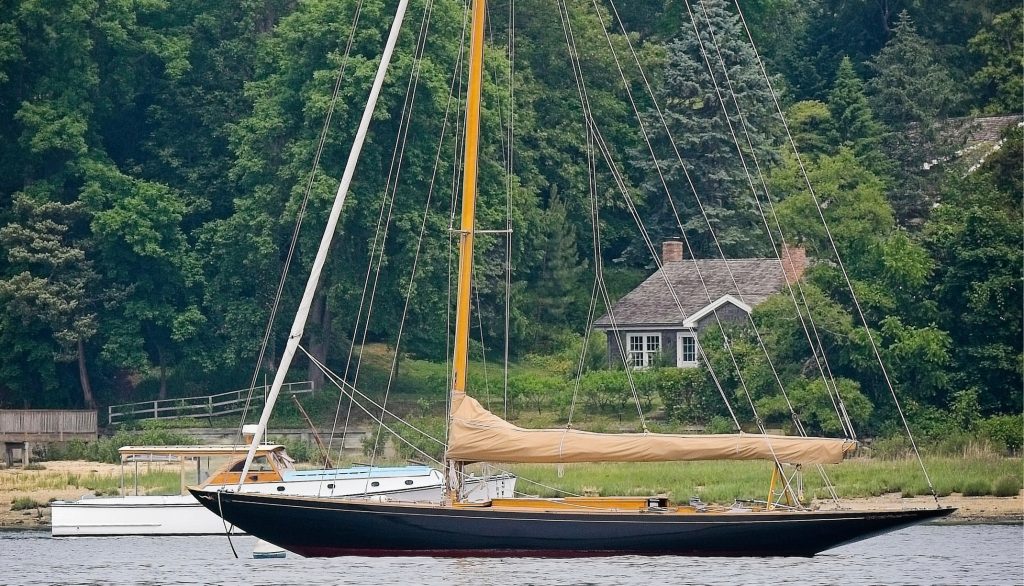
Invader is the other 8 Metre replica crafted at Wooden Boatworks. © Peter Taylor
Fife: Wizard on the Clyde, Favorite in Oyster Bay
From a designer’s eye, Donn has always been partial to the British equivalent of Herreshoff, namely William Fife, Jr. OBE, often referred to as William Fife III of Fairlie. Fife built the majority of his boats in the company yard, near Glasgow. Born a decade after Herreshoff, Fife had a similar impact on his nation’s yacht design and building heritage right up to World War II. He designed around 600 yachts, including two contenders commissioned by Sir Thomas Lipton for the America’s Cup. He started building yachts in 1890 and he built his last design in 1938. According to Wikipedia, there “are somewhere less than one hundred Fife designs still in existence. Of these, there are around fifty still sailing…”
Donn has restored one of those active boats, Clio, and built the most spectacular examples of a new build to a classic 8 Metre design from 1929, Defender and Invader; the former white and the latter black. Sporting the Fife trademark golden Chinese dragon at the stem, these boats were built as replicas of the 8 Metre that competed in the 1932 and ‘34 Canada’s Cup.
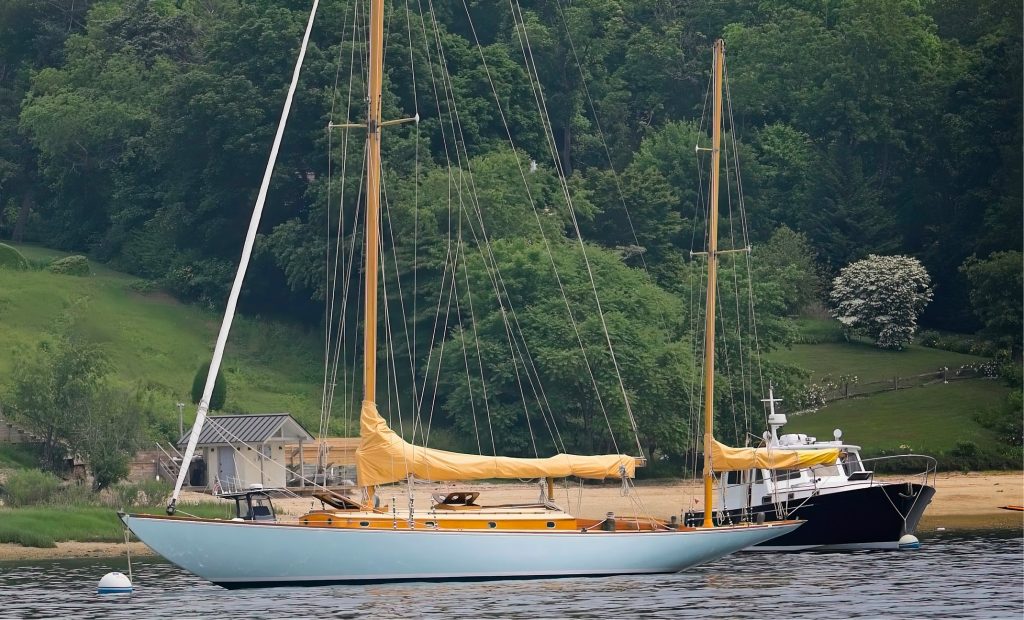
Designed by Bill Luders, Storm is a Decoursey Fales Trophy winner. © Peter Taylor
The Quest for Fife
The 8 Metres show the design genius of the Master of the Clyde, William Fife III. Hunt Lawrence recalls that the search for Fife started with a cutter that resembled a modern Pacific Seacraft design. Anne Caie (designed by Sam Crocker) and the ultra-classic Herreshoff Dolphin were the first Oakcliff Classics.
“We got Anne Caie through Roxy Darling, who had a connection,” Hunt recalls. “She and Donn were working together. We were going about looking for Fifes. Clio was a boat we had an eye on, but we couldn’t acquire her so we bought Dolphin. We shipped Dolphin to the Med and got into some racing there with a paid crew. And from there we got Caper (the 52-foot Rhodes design). Then surprise, Clio came up for sale. She was sitting at the mooring on the South Shore looking a little sad, and we got her redone.”
The 8 Metre Project
One of the most stunning pairs in the collection, Defender and Invader, had their origin in a scarcity of original 8 Metres. “We couldn’t buy any Eights, so Donn built two,” said Hunt. “They were very expensive to build, from Fife designs of the early 1930s.” Pictures of Invader show the profile of a Depression era Fife design from the library of the Glasgow designer who built watercraft from dinghies up to America’s Cup challengers, including Sir Thomas Lipton’s Shamrock III.
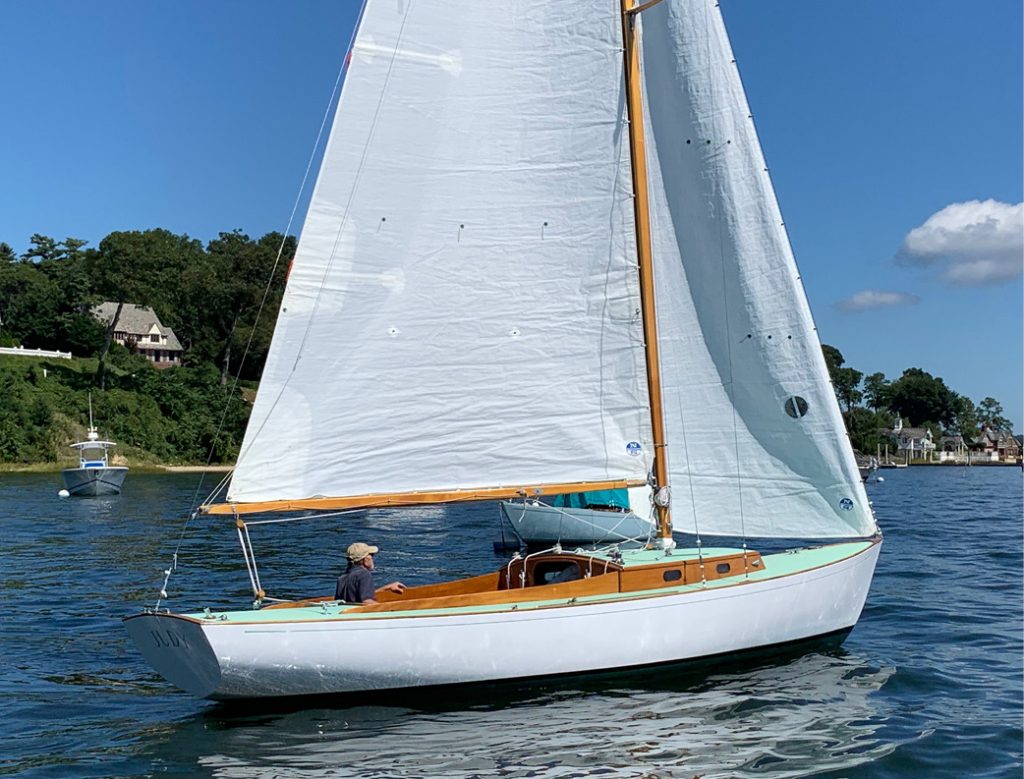
Judy starts first in the Oakcliff Classics pursuit races, frequently leading her bigger rivals across the finish line. © Conversations with Classic Boats
Herreshoff by the Numbers: 29s and 30s
Hunt continued to trace the evolving history of the Classics fleet. “Then we were given Mischief, so we had the two Herreshoffs, Dolphin and Mischief. For the New York 30s, we found the owner of Nautilus (the white NY 30). The boat was pretty run down, so we brought her back. And then Banzai (the black 30) came up.”
The most charming Oakcliff Classics story is that of Judy, a post-war design that was commissioned as a class daysailer, 24 feet long, for a yacht club fleet. The hull resembles a small Dolphin, but she was an Olin Stephens design. Built in Huntington by Knudsen, Judy apparently did not meet the needs of the Seawanhaka members who had put in a prototype order. Back in the Knudsen shed for a rest, Judy was discovered by Donn, not just intact but in great sailaway condition. In the weekly pursuit races on Oyster Bay, Judy leaves first, often outrunning the bigger boats that follow.
Today Donn is retired; he has seen the yard sold to a new owner who carries on the job of keeping twenty well used vintage yachts looking good. His retirement project is building a boat, for himself and his wife. It’s a 25-foot sloop, suitable for the thin waters of Long Island’s Great South Bay.
His boatbuilding legacy floats along the Centre Island coast in Oyster Bay: two vintage Fife craft, two Newport 29s and two NY 30s (100% Herreshoff), and two newly built Fife 8 Metres. Add to that group Storm, a 1960 Bill Luders renegade design that won the Decoursey Fales Trophy, the offshore series of Long Island Sound, in a fetching shade of blue. At a distance, they look like toy boats spread on a blue-green carpet. Closer up, they are a living, floating museum of the last 100 years’ most important yacht designers.
I thought, “How appropriate that Donn Costanzo would have picked Greenport, the end of the line of the North Fork as the place for his Wooden Boatworks shop.” My own relatives must have happened through this fishing town in the mid 19th century on a migration that landed my great-grandfather, William Darling, as a sailmaker in City Island. His Valentine Sails logo was a heart, and a Valentine sail bag can be seen in an exhibit in the seasonal City Island Museum. To my knowledge, Donn didn’t mark his boats, or at least I never saw one on Dolphin while I was sailing her in Oyster Bay or Nantucket. ■
Not a formally trained historian nevertheless a boat storyteller, collecting and reciting stories for the boating curious, Tom Darling hosts Conversations with Classic Boats, “the podcast that talks to boats.” Tune in via Apple Podcast, Google Podcast or Spotify, or online at conversationswithclassicboats.com.




